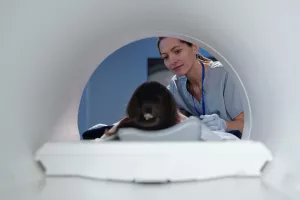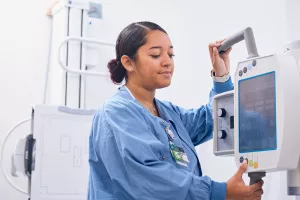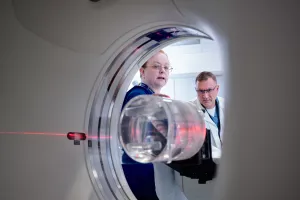Picture this: a team of professionals working with you to get the right information to help diagnose and treat your child. That's exactly what happens when your child receives imaging services such as X-rays or MRIs. We may not have a superhero's X-ray vision but we do have the latest super-powered technology and the strongest team to safely care for your child.
Seeing the full picture of your child
We're ready to see what's on the inside — perhaps a broken bone or a small cyst — but we never forget that a whole child is coming to see us. And that child and their family may be a bit nervous. That's why every visit here starts with a conversation. We'll talk about what service is needed and how we'll work together to make everything comfortable and safe for your child.
We have a pediatric-focused team who've studied how to care for children specifically and hold advanced pediatric radiology certifications. We know that children aren't just small adults. They're growing and developing young people. So, we customize care for your child's exact age and stage of development.
We hope we've made the picture clear for you: our family-centered approach combined with the most advanced technology ensures fast, accurate and safe results to help you and your child.

Testing
The imaging services we provide are extensive and will be designed to meet your child's needs. We also partner closely with the pediatrician or specialist who sent you to us. We collaborate with them frequently and send a detailed report about our findings.
Our team is part of The Image Gently Alliance, a national coalition of caregivers committed to providing the lowest dose imaging for children. You may also hear the term ALARA, meaning "as low as reasonably achievable." And when it comes to your child's comfort, we have many tools, and in some cases, pediatric-specific anesthesia may be needed, while in other cases, our child life specialists and even our pet therapy dogs can provide the smiles and distractions that the doctor ordered.
Computed tomography (CT) scan images look very similar to X-rays, but with much more detail. CT scanners combine a series of X-rays into a detailed image of a specific body part, such as your brain, chest or leg. Our radiologists can view the resulting scans layer by layer or as a single 3D image. CT scans can help to spot and diagnose conditions like fractures, lung conditions or tumors.
Thanks to the latest low-dose equipment we use in our imaging labs, you can learn so much more about your health with less radiation exposure from CT scans. In fact, our CT scanners use special software to reduce total radiation exposure by up to 40%.
When we are looking for even greater detail about a baby’s development, we may conduct a fetal MRI scan. Like other MRI imaging, fetal MRIs use magnet technology to create high-resolution images — from muscles and connective tissue to internal organs and the central nervous system. Fetal MRIs show more detail than we can achieve with an ultrasound alone. And as with all procedures, we know how to provide this imaging so it is safe and effective for you and your baby.
When a physician needs to understand how something in your child's body is working — such as how the person is swallowing — they may use fluoroscopy. Fluoroscopy is a kind of special X-ray that uses a special technique that looks like a video on TV. With fluoroscopy, we can see your child's organs (such as stomach, esophagus or intestines) in motion. We may ask your child to drink a special liquid or place a small tube in your child's bladder to infuse fluid to help us see better. All procedures can be anxiety-producing, so it may be helpful to have you in the imaging room to help keep your child still and comforted so that we can get the clearest pictures possible.
Interventional radiology (IR) uses the power of image-guiding technologies like a CT scan, MRI, ultrasound or X-ray to perform minimally invasive procedures. Interventional radiology can diagnose and treat certain medical conditions as an alternative to more complex and invasive surgeries. For example, we may use IR to take a biopsy, drain a cyst or help with correct catheter placement. With interventional radiology, most procedures lower the risk of complications with less pain, smaller incisions (usually the size of a pencil tip) and shorter recovery times.
Certain atoms in our cells produce signals when they're in the presence of magnetic fields. Magnetic resonance imaging or MRI machines use those signals to create high-resolution images of your child's body — from muscles and connective tissue to internal organs and the central nervous system. This allows doctors to see organs, tissues and bones without the need for surgery. It helps to identify cysts, tumors or other abnormalities. If your child needs anesthesia to have an MRI, our specially trained pediatric team is available to assist. We're also good at providing distractions to help your child relax for the session.
Nuclear medicine is a type of radiology that uses tiny amounts of radioactive material to get a clearer picture of the inside of your child's body. Our doctors may recommend nuclear medicine testing to get a clearer view of soft tissue, organs or abnormalities like tumors or cysts.
You can rest assured your child's pediatric-focused care team will use as little radioactive material as possible, and only opt for these services if they’re medically necessary.
PET/CT scan is a combination of 2 imaging techniques in 1 exam. When we look at tissue and organs on a cellular level (PET) and from a bird's-eye view of your body's structure (CT), it gives us a full picture of your child's health. Positron emission tomography (PET) uses a small, safe amount of radiation to examine whether certain cells are healthy or show abnormalities. Computer-assisted tomography (CT) combines a series of X-rays into a detailed image of a specific body part.
When we need to see your child's organs, tissue or blood flow more clearly, we'll use ultrasound imaging. Ultrasounds are great because they don't emit any radiation and your child doesn't have to hold their breath or be completely still for a long period.
Ultrasounds use a small, hand-held wand known as a transducer, which emits high-frequency sound waves. These sound waves travel until they hit a boundary, like an organ or other soft tissues, and create an echo.
When the echoes return to the transducer, they produce images on the ultrasound monitor in real-time.
Perhaps it's an injury on the playground or the sports field, but either way you have concerns that a bone may be broken. It's likely time for an X-ray.
X-rays use a small dose of radiation to create images of the inside of your child's body. Dense structures like bones absorb more electromagnetic energy beams than skin, muscles and other soft tissues. That’s why bones appear light gray or white against a dark background in X-rays.
While X-rays aren’t the most colorful pictures you’ll ever take, the high contrast allows doctors to see if anything is out of the ordinary. And best of all, we make sure the lowest dose of radiation possible is used.
FAQs
In addition to the information below, the Radiology Society of North American and the American College of Radiology have sponsored a website that provides kid-friendly information about imaging procedures. You may want to review with your child before an imaging appointment.
Children — and parents — often have many questions before an imaging exam. Our technologists will be glad to address your concerns during your visit.
One of our technologists will explain the procedure in child-friendly terms before performing the exam.
Following the exam, 1 of our radiologists will review your child's study and provide a full report of the findings to your referring doctor.
This may be a concern for both you and your child. We do everything possible to minimize your child's exposure to radiation. If possible, we perform ultrasound and MRI exams because they do not require ionizing radiation. When X-rays or CT scans are necessary, we use state-of-the-art, low-dose equipment.

From regular office visits to inpatient stays, find the healthcare you need and deserve close to home.

Meet the doctors and care team devoted to supporting you every step of the way along your path to better health.